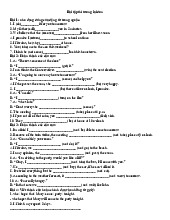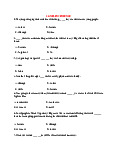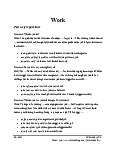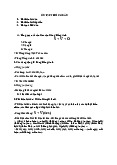

Preview text:
Marketing strategy of Hermes
Hermes’ Brand Philosophy
Hermès' brand philosophy emphasizes quality and refinement, avoiding mass production, manufacturing
lines, and outsourcing. Creative Director Pierre-Alexis Dumas signs off on every Hermès product before
it leaves the workshop. The company's love for craftsmanship and the commitment to quality have
remained firm throughout its 183-year history. All Hermès products are made in France in workshops,
emphasizing the importance of quality and uniqueness. The company's focus on exclusivity and ultra-
premium luxury ensures that its products are only available to the few and are not mass-market luxury.
Hermès does not have a marketing department, but instead relies on intuition and creativity, with
everyone responsible for marketing.
Hermes’ Brand Strategy
Hermès offers products in various categories, including leather goods, accessories, silks, fragrances,
watches, and other items. The company's brand strategy is consistent across these categories, focusing on
its six values: spirit of conquest, creativity, craftsmanship, quality, authenticity, and independence.
Hermès has a long tradition of innovation in the ultra-luxury segment, producing exclusive products to
increase brand allure and attract a rich customer base. In the 1970s, new materials like polyester and
plastic gained popularity. A 1979 French advertising campaign sparked global interest in Hermès scarves,
leading to over 30,000 products by the 1990s.
Hermès has focused on innovation, resulting in brand growth and influence in the ultra-luxury segment.
The "Petit H" project encourages luxurious recycling of leftover raw materials, creating unique, ultra-
luxurious products under the Hermès Petit H collection. This innovative approach aims to create a new
atelier within the brand. Another Hermès' brand strategy emphasizes collaboration, inviting artists to
design iconic products under the Hermès Editeur brand name. These collaborations, not limited to scarfs,
occur in other product categories and portfolios, showcasing the company's commitment to quality and innovation.
Hermes’ brand communication
Hermès' brand communication and marketing strategies are centered on its heritage and exclusivity. The
company celebrates its lifestyle through marketing campaigns and sponsorships, focusing on events that
align with the brand's image and legacy. Hermès also collaborates with independent artists and designers
to increase product visibility. The company's association with horses and horse racing events, such as the
Saut Hermès show-jumping competition in Paris, showcases the brand's fine leather products and its
association with horses. Hermès is an innovative organization, ranking 13 in Forbes' 2014 List of 100
Most Innovative Companies and 29 in Forbes' 2020 List.
The company uses content marketing and social media platforms to engage with its audience. A recent
example is the online pop-up virtual store, lamaisondescarres.com, which features over 600 models of
Hermès signature silks for purchase.
Hermès effectively uses social media to promote its products through two apps: Silk Knots and Parcel
Manager. The company invests in TV, print, video, and visuals to showcase collections and target affluent
readers. They also use humor and comical situations in advertising, such as a 2014 glove ad campaign
and a racetrack-inspired porcelain tableware line Rallye 24.
Hermes’ family business strategy
Hermès, a luxury family business, has been successful for six generations since 1837. The company's
founder, Thierry Hermès, built a reputation as a high-quality saddlery maker using the functional and
decorative "saddle stitch." The business was passed on to his son Emile-Charles Hermès in the 1870s,
followed by his son Emile-Maurice Hermès in 1922. The fourth generation, Robert Dumas, succeeded in
the 1930s and transformed the business into an international luxury retailer. The fifth generation, Jean-
Louis Dumas, made the company public in 1993, turning annual revenues from $82 million to $2 billion.
The sixth generation, Pierre-Alexis Dumas, succeeded in 2010, and Axel Dumas was appointed as CEO in 2014.
Hermès' long-term success is attributed to its strong family ownership, strong values, strong family pride,
and strong financial structure. Going public increased the company's financial stability while enabling
strong family influence. The company adheres to self-financing principles, resulting in a 15% profit
reinvestment back into the company annually. Hermes’ Challenges
Continuous takeover interest from LVHM: Hermès faces a significant challenge from LVMH's
continuous takeover interest, which led to a legal dispute between the two companies. LVMH sold a 23%
stake in Hermès in 2017 to take complete ownership of Christian Dior. Hermès has protected its integrity
and independence by setting up a private holding company with the first right of refusal when a family
member decides to sell shares. In 2011, over 50 descendants of Thierry Hermès pooled their shares into a
co-operative called H51, holding 50.2 percent of the company's shares. The family members'
collaborative and united stand emphasizes the importance of Hermès remaining independent and operating independently.
Succeeding in China: Hermès has adopted a patient approach to targeting the Chinese luxury market,
opening only one store per year from 2015. The strategy focuses on showcasing the brand's legacy and
craftsmanship, while also promoting patience and exclusivity. The Chinese luxury consumer is well-
traveled and exposed to global trends, making it challenging for Hermès to instill a sense of patience. The
company's subdued, underplayed, and exclusive positioning aligns with the government's crackdown on
wealth, bling, and logos. However, Hermès' strategy may face challenges as preferences and needs for luxury change.
Strengthening the Hermes brand equity beyond leather and silk: Hermès' brand equity is strong in
ultra-luxury leather and silk products, but its watchmaking division, La Montre Hermès, has limited
success. Diversification is crucial for luxury houses to hedge against cyclical downturns and shifting
consumer needs. The brand must maintain exclusivity and maintain brand ardour by launching similar
iconic bags and adopting a scarcity model across categories like accessories and watchmaking.
Hermès has a patient strategy targeting the Chinese luxury market, opening only one store annually since
2015. The strategy showcases the brand's legacy, craftsmanship, and exclusivity, aligning with the
government's crackdown on wealth, bling, and logos.




